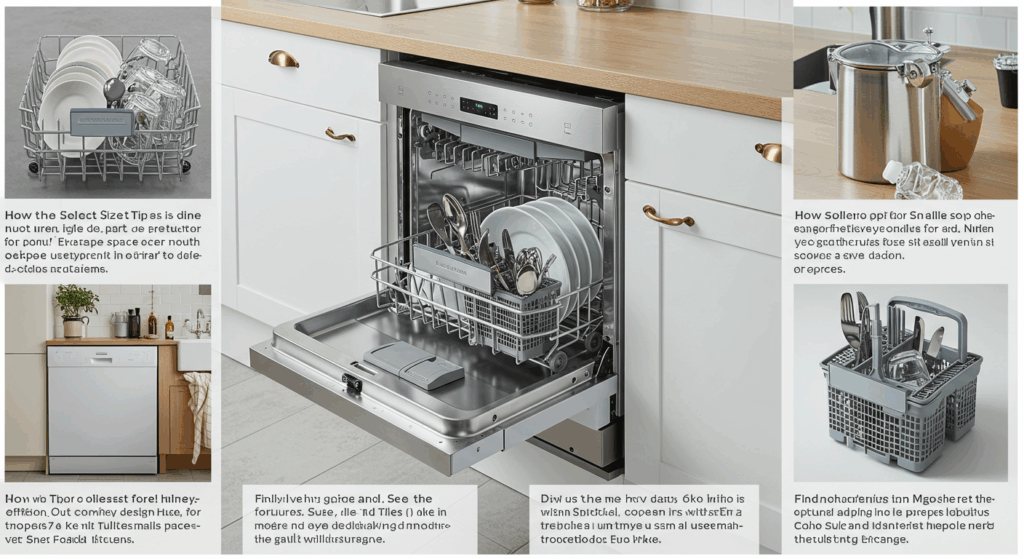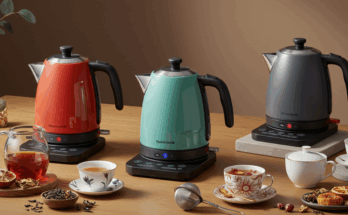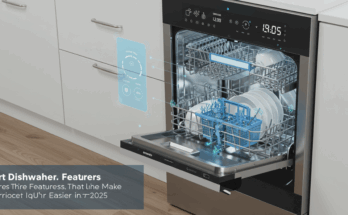In 2025, small kitchens are becoming increasingly common as urban living spaces shrink and homeowners prioritize efficiency. A dishwasher, once considered a luxury, is now a practical necessity for many, even in compact kitchens. However, choosing the right dishwasher for a small kitchen requires careful consideration of space, functionality, and modern features. This guide explores the key factors to consider, including size, types, energy efficiency, noise levels, and innovative features, to help you select the perfect dishwasher for your small kitchen in 2025.
Why a Dishwasher Matters in a Small Kitchen
A dishwasher in a small kitchen can transform your daily routine by saving time, reducing clutter from dirty dishes, and improving hygiene. With advancements in appliance design, dishwashers in 2025 are more compact, efficient, and stylish than ever, making them viable even for tiny spaces. However, the challenge lies in finding a model that fits your layout without sacrificing performance or aesthetics. Here’s how to navigate the process.
Step 1: Assess Your Space and Layout
Measure Your Kitchen
The first step in choosing a dishwasher is measuring the available space. Most standard dishwashers are 24 inches wide and 24 inches deep, but for small kitchens, these dimensions may be too large. Compact options, such as 18-inch-wide models or countertop units, are designed specifically for tight spaces. For example, the Samsung 18-Inch Dishwasher is ideal for small households, offering 8 place settings while fitting into narrow spaces.
- Action Tip: Measure the width, depth, and height of the area where you plan to install the dishwasher. Account for leveling feet adjustments and ensure there’s enough clearance for the door to open without obstructing walkways. A good rule is to leave at least 27 inches of space in front of the dishwasher for comfortable loading and unloading.
Consider Your Kitchen Layout
Small kitchens often follow galley, L-shaped, or Pullman layouts, where efficient use of space is critical. The “working triangle” principle—placing the sink, fridge, and stove in a triangular formation—can guide dishwasher placement for optimal workflow. Ideally, position the dishwasher near the sink for easy plumbing access, as this minimizes installation costs and complexity.
- Corner Placement: Corners are often underutilized in small kitchens. Installing a compact dishwasher in a corner can maximize counter space while keeping the appliance accessible.
- Under-Sink Installation: Some dishwashers, like certain Bosch models, have lower profiles in the back, allowing installation directly under the sink where plumbing is already available.
- End of Unit: If your kitchen layout doesn’t allow for under-sink or corner placement, consider placing the dishwasher at the end of a cabinet run to keep it out of the main workflow.
Step 2: Explore Dishwasher Types for Small Kitchens
Several dishwasher types are tailored for small kitchens in 2025. Each has unique benefits depending on your space and lifestyle.
Compact Built-In Dishwashers
Compact built-in dishwashers, typically 18 inches wide, are perfect for small kitchens with limited cabinet space. Brands like Bosch, Miele, and Frigidaire offer models that deliver full-sized cleaning power in a smaller footprint. For instance, the Frigidaire 18″ Front-Control Dishwasher provides 8 place settings and Energy Star certification, making it suitable for couples or small families.
- Pros: Seamless integration, high cleaning performance, and energy efficiency.
- Cons: Requires permanent installation and may reduce cabinet storage.
Countertop Dishwashers
Countertop dishwashers are ideal for renters or kitchens with no cabinet space for a built-in model. These units, such as those from Danby or EdgeStar, sit on your counter and connect directly to the sink, requiring no permanent plumbing. They typically handle 6 place settings and are perfect for singles or couples.
- Pros: Portable, easy to install, and budget-friendly (starting around $269).
- Cons: Limited capacity and may require frequent refilling of water or detergent.
Drawer Dishwashers
Drawer dishwashers, like the Fisher & Paykel DD24DAX9 DishDrawer, feature two independently operated drawers that slide out like cabinets. They’re ergonomic, energy-efficient for small loads, and ideal for small households. However, they may struggle with oversized cookware.
- Pros: Flexible loading, small load efficiency, and quiet operation (45 dB).
- Cons: Lower capacity and a learning curve for loading compared to traditional models.
Portable Dishwashers
Portable dishwashers, such as GE’s portable model, are mobile units that can be stored when not in use. They connect to your sink and are ideal for kitchens without dedicated dishwasher space.
- Pros: No permanent installation needed, flexible storage.
- Cons: Takes up floor space when in use and may be less aesthetically integrated.
Step 3: Prioritize Energy Efficiency and Cost Savings
Energy efficiency is a top priority in 2025, as eco-friendly appliances reduce utility bills and environmental impact. Look for dishwashers with Energy Star certification, which ensures lower water and electricity consumption. For example, the Miele G 5892 SCVi SL uses only 200 kWh per year, 16.67% more efficient than the standard Energy Star rating of 240 kWh.
- Key Features to Look For:
- Eco Cycles: Use less water and energy for lightly soiled loads.
- Smart Sensors: Adjust water and cycle duration based on soil levels, maximizing efficiency.
- High Energy Star Ratings: Models with A++ ratings, like those from Glen India, offer significant savings.
- Action Tip: Check the estimated annual energy use (in kWh) and water consumption (in gallons per cycle). Models like the Frigidaire FDPC4314AS, priced under $400, are budget-friendly and Energy Star-certified.
Step 4: Consider Noise Levels
In small kitchens, especially in open-plan homes, a noisy dishwasher can be disruptive. Look for models with a decibel (dB) rating below 45 dB for whisper-quiet operation. The Samsung Smart Linear Wash, at 39 dB, is one of the quietest options in 2025, ideal for small spaces where noise carries easily.
- Quiet Mark Certification: This independent scheme identifies the quietest 10-20% of dishwashers annually. Brands like Bosch and Miele often receive this certification.
- Action Tip: Compare dB ratings on the energy label. A rating of A (quietest) is preferable for small kitchens.

Step 5: Evaluate Features for Convenience and Performance
Modern dishwashers in 2025 come with advanced features that enhance functionality, especially for small kitchens where versatility is key.
- Adjustable Racks: Flexible racks and fold-down tines, like those in the Whirlpool WDT750SAKB, accommodate larger items like pots or water bottles.
- Third Rack: A third rack, found in models like the KitchenAid Printshield, adds space for small utensils or baby items, maximizing capacity.
- Specialized Jets: Bottle jets (e.g., GE and Electrolux) and silverware spray jets ensure thorough cleaning of specific items.
- Smart Features: Wi-Fi-enabled dishwashers, like the Bosch 500 Series, allow remote monitoring and cycle customization via apps. Amazon Dash Replenishment automatically orders detergent pods when you’re low.
- AutoDos Technology: Miele’s high-end models, like the G 7986 SCVi, feature automatic detergent dispensing for precise cleaning.
- Drying Performance: Fan-assisted drying or auto-release doors (e.g., Bosch AutoAir Dry) ensure dishes, especially plastics, dry thoroughly.
Step 6: Match Style to Your Kitchen Aesthetic
A dishwasher in a small kitchen should blend seamlessly with the design. In 2025, aesthetic trends favor integration and customization.
- Panel-Ready Models: These dishwashers, like the Miele G 7986 SCVi, allow you to attach a custom cabinet panel for a cohesive look.
- Color and Finish: Stainless steel remains popular, but fingerprint-resistant options from Whirlpool or colorful models from Smeg add flair.
- Handleless Designs: Handleless or top-control dishwashers, like those from Maytag, create a minimalist, uncluttered appearance.
- Action Tip: Choose a finish that matches your cabinetry or opt for a contrasting color for a bold statement. For example, a high-gloss finish reflects light, making the kitchen feel larger.
Step 7: Budget and Brand Reliability
Dishwasher prices in 2025 range from $360 for budget models to $3,700 for luxury units. Most small kitchen dishwashers fall between $400 and $1,200, balancing performance and features.
- Reliable Brands: Bosch, Miele, and Thermador top reliability rankings, followed by Whirlpool, Maytag, and Frigidaire.
- Warranty: Look for at least a one-year warranty on parts and labor. Miele offers a two-year warranty, while Maytag provides a 10-year warranty on racks and tubs.
- Action Tip: Check for discounts during sales events like Prime Day or visit trusted retailers like Home Depot or Best Buy for deals.
Step 8: Installation and Maintenance
- Plumbing and Electrical: Ensure your kitchen has the necessary hookups. Countertop and portable models require less complex installation.
- Maintenance: Clean filters every three months and use manufacturer-recommended descaling solutions to prevent clogs.
- Action Tip: Consult a professional for built-in installations to avoid plumbing issues, especially in older homes.
Conclusion
Choosing a dishwasher for a small kitchen in 2025 involves balancing space constraints, performance, and style. By measuring your space, exploring compact options like 18-inch built-ins or countertop models, prioritizing energy efficiency, and selecting features like adjustable racks or smart technology, you can find a dishwasher that enhances your kitchen’s functionality and aesthetic. Brands like Bosch, Miele, and Samsung offer reliable, innovative options tailored for small spaces. With careful planning, your small kitchen can enjoy the convenience of a dishwasher without compromising on space or style.



